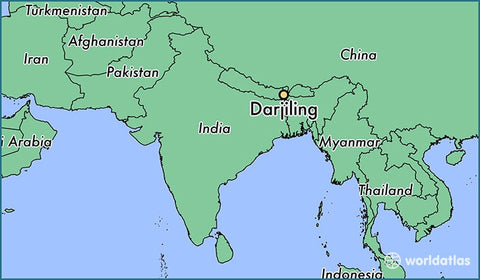Far from the news reports in the USA, massive protests have shut down Darjeeling, the famous tea growing region, for the last two months.
Lives have been lost, and industries decimated. Considering that this is an important issue in tea, we want to give you a brief overview of current issues in Darjeeling.
Darjeeling Problems have been a long time coming

Darjeeling is tea growing region located in the Himalayas. It is home to 87 tea estates. Unlike Assam, Darjeeling teas are grown on hillsides at high altitudes. Elite tea drinkers seek out these teas for their light, subtle flavors, and floral aroma.
Lately, tea production problems have compounded in Darjeeling. The region has been suffering from changing weather patterns and drought – likely a result of climate change. Each year, the industry waits for rains to come at the proper times and in the proper amounts. In the last 5 years it has not. The rain comes very sporadically and if it comes at all, it tends to downpour, flooding lands, and eroded away topsoil.
Additionally, due the high labor costs of working on the steep slopes, replanting in the region has ground to a halt. Some bushes have reached 150 years of age, planted at the birth of the Darjeeling tea industry itself. The combination of age and bad weather has weakened the bushes, allowing for pests, such as red spider mite, tea mosquito bug, and blister blight to run rampant, further weakening plants.
On the labor front, Darjeeling suffers from a worker population that finds itself alienated from the rest of the state, West Bengal. West Bengal is ethnic majority Bengali. The majority of Darjeeling’s population is Gorkhas, or ethnically Nepali.
The Gorkhas have fought for control region of the region since 1780. Even before India’s independence, locals have called for a separate state of the Darjeeling hills, and eventually settling on the name of Gorkhaland. Since independence, the local people have protested for Gorkhaland repeatedly, most infamously in 1986 when the protests left over 1,200 dead. (To clarify, the Gorkhas still want to be part of India, they just want their own state.)
The 1986 unrest resulted in the formation of a special Gorkha council. However, this council had very little governing control, and ultimate has failed to placated the Gorkhas. The Gorkhas have continued to demand a separate state of Gorkhaland, and leading to more protests in 2007, 2011, and 2013.
The combination of all these problems has contributed to a drop in Darjeeling tea production of 5.5 million kg annually since 1990.
The Current Turmoil

On May 12, 2017, the West Bengal education ministry made Bengali language education mandatory in Darjeeling. Because a majority of people in the hills do not speak Bengali, this upset the local people who began taking their anger to the streets.
The situation escalated. The government shut down the internet. The police charged at protesters with batons. The army was eventually called. Protesters set fire to buildings. Police claim they were shot at by protesters. Protesters have been killed.
The protests reignited the long standing call for Gorkhaland separate from West Bengal. On June 16, a general, indefinite strike was called for all workers in the region. As it stands now (Aug 18, 2017) there are no visible signs that the protest will end within the tea season.
What this means for your cup of tea?
If you drink pure Assam, Chinese, or Japanese tea- not much. There will not be tea shortages. Prices on higher end black teas – like Golden Tips, or TGFOP1— from other regions are likely to increase as elite tea drinkers seek substitutes.
HOWEVER, if you drink Darjeeling tea, your favorite cuppa might be in trouble. This is the first time in 156 years of tea auctions that there have been NO Darjeeling tea for sale. This shortage will cause single origin Darjeeling teas to shoot up in price. Additionally, many tea bag blends feature some Darjeeling to add a distinctive character. Lack of access to Darjeeling tea might change the taste of these blends in 2017.
Also, unscrupulous sellers pass off Chinese and Nepalese teas as Darjeeling. With the market being completely void of Darjeelings, it is prime time for fakes. As a consumer, be on the lookout for fake Darjeeling tea. You can tell if your tea is an authentic Darjeeling by looking for this label.
Even after the current protests subside, the tea industry in the region may not recover. In cool season, tea estates invest heavily in pruning, replanting, and the repairs of worker homes and factory structures to prepare for the next tea flush. Without the proceeds from 2017 tea sales, estates might not have the capital to undertake these critical activities, disrupting Darjeeling’s 2018 flush and potentially exacerbating the plant stress caused by climate change and pest attack.
It has been a complete shut down of business. It is a horrifying to not know how things will unfold. For the sake of the workers, the estates, the region and Darjeeling tea lovers all over the world, one can only hope the situation is resolved soon and the gardens can bounce back.

